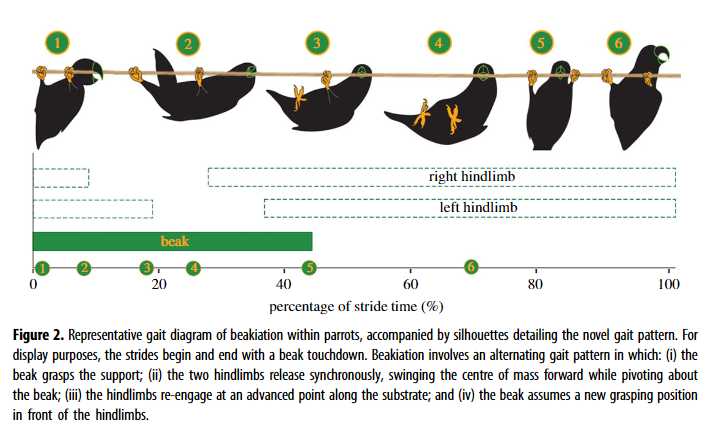While you might hear parrots and think of them flying majestically through the trees in the Amazon – or even that one time a flightless parrot in New Zealand got up close and personal with a zoologist – your mind probably wouldn’t go to the idea of them swinging through the forest by their beaks. However, a recent study has revealed a new kind of gait for these birds: “beakiation”.
By looking at the way four rosy-faced lovebirds (Agapornis rosiecollis) moved along a suspended pole using their beaks, the team thinks this is the first species to be recorded to move in this way. They have given the method of moving in the manner of suspensory beak-driven locomotion the name beakiation. These lovebirds have already been observed climbing up walls using their beaks, and have now taken the motion sideways.
The researchers set up two experiments to find out more about how the birds were moving. The first featured a suspended thin “branch” with pressure plates attached to a large wooden platform so the team could find out how much force was on a single limb and analyze the center of mass movements associated with beakiation, with 129 trials conducted in this manner. The branch was too thin to walk along, so the birds had to get creative.
“The smaller the substrate, the harder it is to stay upright without toppling over, so the natural solution would be to go underneath and just hang,” says co-author Melody Young told Smithsonian Magazine.
A modified version was also tested to collect the single limb forces acting during beakiation. The length of the support was shortened. In total, 500 strides from 142 trials were carried out using this modified apparatus. Movements of the birds in both experiments were recorded by two high-speed cameras.
No training was involved – rather, the birds simply used a way to move along the suspended beam when presented to it during the experiment. “We just put them up there, and all four birds chose to adopt this same behavior,” said Young.
Through studying the videos, beakiation was found to begin with the beak grasping the suspended rod, and then both hind legs being released to swing forwards with the center of mass. The feet then grasp a new position on the rod, and the beak then grasps in front of them before the whole process starts again (as can be seen in the above video).

The different stages of beakiation.
The force on the beak is equal to the force a gibbon would place on its arms while swinging through the trees, though beakiation has a slower more careful nature, meaning the birds recover only about 25 percent of the energy between swingas compared to a gibbon’s roughly 80 percent recovery.
The researchers believe this is a brand new undocumented method of locomotion for these birds and is different from other known methods of moving via beak, such as what has been observed from the Puerto Rican spindalis (Spindalis portoricensis), though this is only an oral account and has no video or photograph evidence.
The team highlights that while this new method of travel was carried out during experimental conditions, it should not hide the extraordinary capabilities of these animals and their beaks.
The paper is published in the journal Royal Society Open Science.
Source Link: Watch A Parrot Swing On Its Beak Like A Monkey In World First Footage